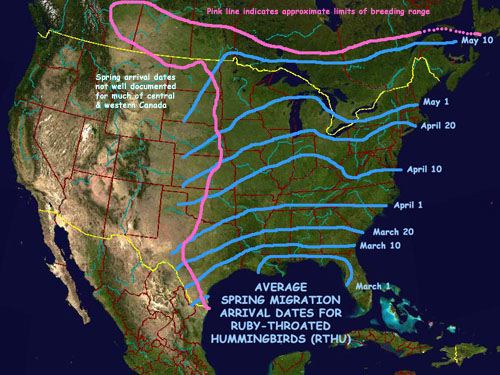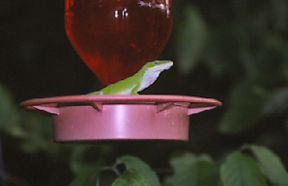-- HUMMINGBIRD Q & A --
Feeders & Feeding #1
(Also see the pages about Hummingbird Feeders.)
The questions below come in part from visitors who leave messages on the Operation RubyThroat website. Please send your own questions to QUESTIONS, or post them on the Guestbook page.
1. When should I put my hummingbird feeders up in Spring?
- Ruby-throated Hummingbirds (Archilochus colubris) begin leaving their wintering grounds in February; the earliest migrants arrive along the Gulf Coast later that month, with a big influx coming by early April (see map below for approximate early arrival dates) At Hilton Pond Center for Piedmont Natural History--headquarters for Operation RubyThroat: The Hummingbird Project in York, South Carolina USA--our earliest RTHU came on 27 March. For most of the southern U.S., you should always have your feeders no later than 1 April, a few weeks later in the northern U.S. and Canada. DON'T wait until you see your first hummers; that might not be until mid-summer when they've already been back for two months or more.

All text, photos & maps © Bill Hilton Jr. & Operation RubyThroat
2. I've heard conflicting stories about red food coloring in hummingbird feeders. Will it hurt them or not?
- There is no scientific evidence that red food coloring harms Ruby-throated Hummingbirds (Archilochus colubris). Back in the 1970s when Red #2 food coloring was outlawed by the Food & Drug Administration, people had been in the habit of adding it to sugar water when feeders were hand-made. Today, however, nearly every commercially made feeder has some amount of red on it, so food coloring isn't really necessary. If you don't need it, why use it--even if it might not matter?
3. I have other birds visiting my hummingbird feeders. Is this unusual?
- Dozens of birds species have been documented at feeders put out for Ruby-throated Hummingbirds (Archilochus colubris). Most common seem to be Baltimore Orioles (Icterus galbula), Orchard Orioles (I. spurius), House Finches (Carpodacus mexicanus), and chickadees and titmice (Parus spp.).

All text & photos © Bill Hilton Jr. & Operation RubyThroat
|
Hummingbirds--and other birds--are not the only creatures that visit sugar water feeders. In 1999, this adult male Carolina Anole (Anolis carolinensis) made daily trips to a hummingbird feeder at Hilton Pond Center for Piedmont Natural History, lapping up the artificial nectar; he undoubtedly munched on insects that also were attracted to this super-rich food source. |
4. Is it possible to estimate how many hummingbirds I have at my feeders?
- Dr. Bill Calder studied Black-chinned Hummingbirds (Archilochus alexandri)--the similar-sized western counterpart of the Ruby-throated Hummingbird (A. colubris)--and determined that a gallon (128 fluid ounces, or 3.79 liters) of 4:1 sugar water would feed about 750 black-chins for a day. Most hummingbird feeders are smaller than one gallon in volume, so according to Dr. Calder's formula a typical eight-ounce (237ml) feeder would satisfy about 47 Ruby-throated Hummingbirds per day. Thus, a 16oz feeder would feed 94 hummingbirds, and so on.
- Another rule of thumb is that a hummingbird, on average, needs to consume approximately its weight per day in nectar (or sugar water). During the breeding season, a typical male Ruby-throated Hummingbird weighs about 3g (0.1oz), and females weigh about 3.5g (0.12oz). Thus, an eight-ounce feeder would feed about 79 male RTHUs or 68 females--but only if no other food sources were available. (Compared to Dr. Calder's more precise compilations, it might be more accurate to say that a hummigbird needs to comsume about 65% of its weight in sugar water per day.)
- In our own banding work, we have determined that if you count the number of hummingbirds you observe at your feeders and flowers and multiply by three, you will likely get a rough estimate of how many birds you actually have.
- The only true way to accurately determine how many hummingbirds you have locally is for a licensed bander to capture all of them.
Back to Hummingbird Questions & Answers
Up to Top of Page
If you found this information useful or interesting, please
Support
Hilton Pond Center for Piedmont Natural History
&
Operation RubyThroat: The Hummingbird Project
It's painless, and YOU can make a difference!
Just CLICK on a logo below.
|
Make direct donations on-line through
Network for Good:
|
 |
|
LIKE TO SHOP ON-LINE?
Donate a portion of your purchase price from 500+ top on-line stores via iGive:
|
|
|
Use your PayPal account
to make direct donations:
|
|
|
|

|
Operation
RubyThroat's
On-Site
Search Engine
|
|
 Operation RubyThroat is a registered trademark of Bill Hilton Jr. and Hilton Pond Center for Piedmont Natural History in York, South Carolina USA, phone (803) 684-5852. Contents of the overall project and this website--including photos--may NOT be duplicated, modified, or used in any way except with the express written permission of the author. To obtain permission or for further assistance on accessing this website, contact Webmaster. Operation RubyThroat is a registered trademark of Bill Hilton Jr. and Hilton Pond Center for Piedmont Natural History in York, South Carolina USA, phone (803) 684-5852. Contents of the overall project and this website--including photos--may NOT be duplicated, modified, or used in any way except with the express written permission of the author. To obtain permission or for further assistance on accessing this website, contact Webmaster.
|


